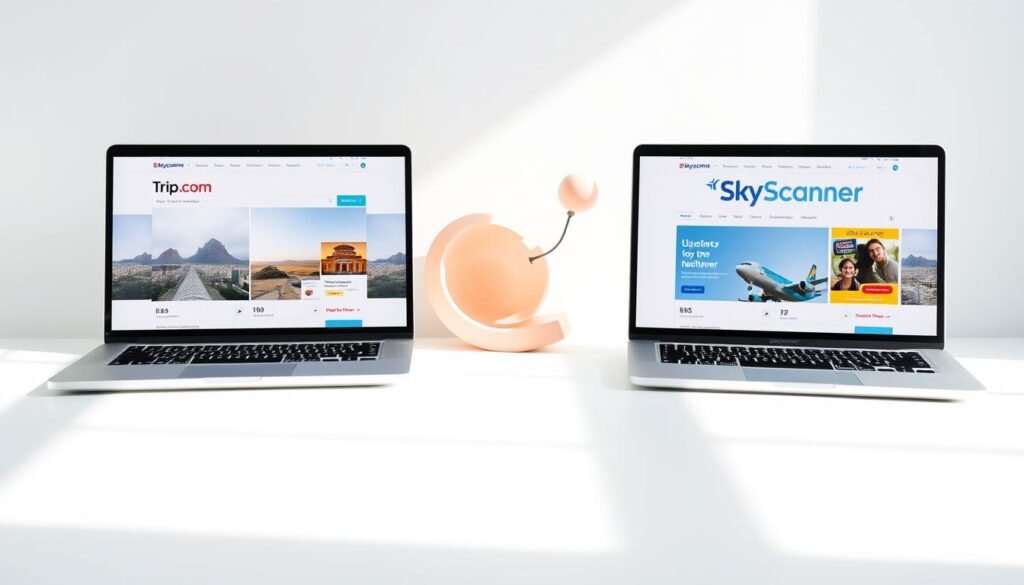When planning travel, many users wonder: is Trip.com the same as Skyscanner? While both platforms belong to the same parent group, they offer distinct services and features. Trip.com, a global travel conglomerate, provides a wide range of travel services, including flights, hotels, and attractions. Skyscanner, on the other hand, focuses primarily on flight and travel comparisons, offering unbiased search results.
Thank you for reading this post, don’t forget to subscribe!Both platforms have evolved significantly over the years. Trip.com, with over 45,000 employees and 400 million users, has expanded its services to include 1.7 million hotels and 600 airlines. Skyscanner, known for its no-commission approach, ensures price transparency for users. Understanding these differences is crucial for making informed travel decisions.
Whether you’re booking a flight or searching for the best hotel deals, both platforms cater to global travelers. However, their approaches differ. Trip.com offers a price match guarantee, while Skyscanner’s low fare calendar helps users find the best prices. These tools empower travelers to make smarter choices.
Key Takeaways
- Trip.com and Skyscanner are part of the same parent group but offer different services.
- Trip.com provides a broader range of travel services, including hotels and attractions.
- Skyscanner focuses on unbiased flight and travel comparisons.
- Both platforms cater to a global audience with user-friendly tools.
- Understanding their differences helps travelers make informed decisions.
Understanding the Background of Leading Travel Platforms
Travelers often explore various platforms to find the best deals and services. Two prominent names in this space are Trip.com and Skyscanner. While they share a common parent group, their services and approaches differ significantly.
Overview of Trip.com and Skyscanner
Trip.com serves as a one-stop-shop for travel needs, offering flights, hotels, tours, and train tickets. It operates in 19 languages, catering to a diverse audience. Skyscanner, now a subsidiary of Trip.com Group, is renowned for its flight search capabilities, providing unbiased comparisons.
Historical Development and Industry Evolution
Trip.com originated from Ctrip, expanding globally after acquiring Skyscanner in 2016. This acquisition marked a significant step in broadening its service range. Skyscanner, founded in 2003, gained popularity for its user-friendly interface and comprehensive search results.
| Feature | Trip.com | Skyscanner |
|---|---|---|
| Services | Flights, Hotels, Tours, Train Tickets | Flight Comparisons, Hotel, Car Rentals |
| Focus | Comprehensive travel solutions | Flight and travel comparisons |
| Key Features | Price match guarantee, Low fare calendar | Unbiased search results, Price alerts |
| Target Audience | Global travelers seeking diverse options | Travelers prioritizing flight comparisons |
Both platforms have evolved with technological advancements and global demand, enhancing their services to meet traveler needs. Understanding their backgrounds helps users choose the right platform for their travel planning.
is trip.com the same as skyscanner?
Many travelers wonder if Trip.com and Skyscanner are the same. While they share the same parent company, Trip.com Group, they cater to different travel needs. Trip.com offers a wide range of services, including flights, hotels, and attractions, making it a one-stop-shop for travelers. On the other hand, Skyscanner specializes in flight and travel comparisons, providing unbiased search results.
Defining the Core Differences
The core differences lie in their services and user interfaces. Trip.com focuses on comprehensive travel solutions, offering features like a price match guarantee and a low fare calendar. In contrast, Skyscanner is known for its price transparency and tools like “Explore Everywhere,” which helps users find the cheapest flights globally.

How Parent Company Relationships Influence Services
Despite being under the same parent company, Trip.com and Skyscanner maintain distinct branding and services. This separation allows them to target different customer needs. The acquisition of Skyscanner by Trip.com Group in 2016 enhanced service integration and technological advancements, benefiting users with shared resources and innovations.
Key Features and Booking Options
When it comes to travel planning, understanding the tools and features of platforms like Trip.com and Skyscanner can make a big difference. Both platforms offer unique capabilities designed to enhance your travel experience.
Comprehensive Search and Booking Capabilities
Trip.com stands out as a one-stop-shop for travel needs. It offers extensive search and booking options for flights, hotels, tours, and even train tickets. This makes it ideal for travelers looking to plan every aspect of their trip in one place.
Skyscanner, on the other hand, is renowned for its innovative “Everywhere Search” feature. This tool allows users to find destinations within their budget, offering flexibility for those who haven’t decided on a specific location.
Price Comparison Tools and Low Fare Calendars
Skyscanner’s price comparison tools provide transparency and flexibility in flight booking. The platform’s low fare calendar is a standout feature, helping users identify the best price options for their travel dates.
Trip.com also offers a price match guarantee, ensuring users get the best deals. Additionally, both platforms provide price alerts, keeping users informed of any fluctuations in prices.
Mobile App, Rewards Programs, and Multilingual Support
- Both platforms offer mobile apps with user-friendly interfaces, enhancing the booking experience on the go.
- Trip.com’s app supports 16 languages, catering to a global audience, while Skyscanner’s app is noted for its ability to deliver price alerts directly to mobile devices.
These features, combined with rewards programs, make both platforms appealing to frequent travelers seeking convenience and value.
Pros and Cons Analysis of Each Platform
Choosing the right travel platform can significantly impact your booking experience. Both Trip.com and Skyscanner have their strengths and weaknesses, which are important to consider when planning your travel.
Trip.com Advantages and User Concerns
Trip.com stands out for its 24/7 multilingual support and all-inclusive travel bookings, making it a convenient option for global travelers. The platform also offers rewards incentives to loyal customers. However, some users have reported issues with booking cancellations and higher rebooking fees, which can be frustrating for those with changing plans.
Skyscanner Strengths and Limitations
Skyscanner is praised for its no booking fees and clean interface, which simplifies the search process. Its broad search flexibility is a major advantage for travelers exploring various options. However, Skyscanner’s reliance on third-party booking can sometimes lead to confusion and complications with customer service.
| Feature | Trip.com | Skysscanner |
|---|---|---|
| Advantages | 24/7 multilingual support, all-inclusive bookings, rewards | No booking fees, clean interface, broad search flexibility |
| Concerns | Booking cancellations, higher rebooking fees | Third-party booking issues, customer service complexity |
In summary, both platforms offer unique benefits but also have specific drawbacks. Trip.com excels in comprehensive services and support, while Skyscanner shines with its flexible search options and transparency. Understanding these pros and cons will help travelers make an informed decision that best suits their needs.
Additional Travel Services and User Perks
Modern travel platforms have evolved to offer more than just basic flight bookings. They now provide a wide range of services designed to enhance your travel experience. From hotels and tours to transportation ticketing, these platforms aim to cater to all your travel needs in one place.
Diverse Booking Options Beyond Flights
Both Trip.com and Skyscanner have expanded their services to include hotels, tours, and even train tickets. Trip.com, for instance, offers over 1.1 million hotels and flights from more than 510 airlines, making it a one-stop-shop for travelers. Skyscanner, while focusing on flights, also provides options for car rentals and hotels, ensuring a seamless travel experience.
These platforms now include services like transportation ticketing and rental services, allowing users to book everything from flights to ground transportation in one place. This integrated approach simplifies travel planning and reduces the hassle of dealing with multiple providers.
Exclusive Promotions and Rewards Incentives
To attract loyal customers, both platforms offer exclusive promotions and rewards programs. Trip.com features a rewards program where users can earn Trip Coins with every booking, redeemable for various services. The platform also offers discounts on car rentals and train tickets, providing additional savings for travelers.
Skyscanner, on the other hand, focuses on price transparency and tools like price alerts, helping users find the best deals. Both platforms emphasize the importance of these additional services in making travel decisions, ensuring a convenient and cost-effective experience for their users.
Industry Impact, Technology, and Historical Insights
Trip.com Group has significantly influenced the travel industry through strategic acquisitions and technological advancements. The acquisition of Skyscanner in 2016 marked a pivotal moment, enabling the integration of comprehensive travel services and enhancing global reach.
Technological Innovations Driving the Travel Search Industry
Technological advancements have reshaped how travelers search and plan their journeys. Trip.com has introduced AI-powered tools like TripGenie, which personalizes travel recommendations. Skyscanner’s “Everywhere Search” feature allows users to explore destinations based on budget, exemplifying how technology enhances travel planning.

The Role of Acquisitions and Global Expansion
Acquisitions have played a crucial role in Trip.com Group’s expansion. The purchase of Skyscanner in 2016 for £1.4 billion was a landmark deal, strengthening their position in the global market. This acquisition allowed Trip.com to integrate Skyscanner’s flight comparison capabilities, offering users a more comprehensive travel service.
How Market Trends and Government Policies Affect Operations
Market trends and government policies significantly impact travel platforms. During the COVID-19 pandemic, Skyscanner released a live COVID-19 restrictions map, aiding travelers in navigating changing regulations. Post-pandemic, there’s a focus on sustainability and safety, influencing service developments and user priorities.
| Aspect | Impact | Example |
|---|---|---|
| Technological Innovations | Enhanced search and planning | AI-powered tools, Everywhere Search |
| Acquisitions | Global expansion and service integration | Skysscanner acquisition by Trip.com |
| Market Trends | Shifts in traveler behavior and priorities | Focus on sustainability post-pandemic |
These factors collectively drive the evolution of the travel industry, with Trip.com Group at the forefront of innovation and strategic growth.
Conclusion
When planning your next journey, understanding the differences between Trip.com and Skyscanner can greatly enhance your travel experience. Both platforms, under the Trip.com Group, cater to distinct needs: Trip.com offers a wide range of services including flights, hotels, and tours, while Skyscanner excels in flight comparisons with tools like “Everywhere Search.”
Trip.com’s price match guarantee and Skyscanner’s price alerts are standout features. While Trip.com provides comprehensive travel solutions, Skyscanner’s unbiased search results make it ideal for flight-focused users. Both platforms offer user-friendly apps and exclusive promotions, ensuring a seamless booking process.
Consider your priorities—whether it’s booking flexibility, service quality, or price transparency. By comparing these aspects, you can choose the platform that best fits your travel needs and preferences.

